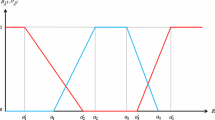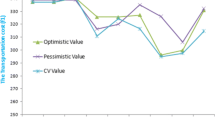Abstract
In this paper, we propose a method to solve linear programming network problems with constraints using interval type-2 fuzzy variables. The method is developed using generalized credibility measure, and lower and upper membership functions of an interval type-2 fuzzy variable. This method has been applied to solve a solid transportation problem with availabilities and demands of a product, and conveyance capacities, which are represented by trapezoidal interval type-2 fuzzy variables. Moreover, we have also shown that different types of problems with objective function having interval type-2 fuzzy parameters can be solved using the proposed method. Apart from a solid transportation problem, we demonstrate its applicability by solving two different network problems: (i) a shortest path problem and (ii) a minimum spanning tree problem. Suitable numerical examples are provided to illustrate the proposed method




Similar content being viewed by others
References
Aliev, R. A., Pedrycz, W., Guirimov, B., Aliev, R. R., Ilhan, U., Babagil, M., et al. (2011). Type-2 fuzzy neural networks with fuzzy clustering and differential evolution optimization. Information Sciences, 181(9), 1591–1608.
Chen, T. Y. (2013). An interactive method for multiple criteria group decision analysis based on interval type-2 fuzzy sets and its application to medical decision making. Fuzzy Optimization and Decision Making, 12(3), 323–356.
Dubois, D., & Prade, H. (1998). Possibility theory: An approach to computerized processing of uncertainty. New York: Plenum.
Figueroa-García, J. C., & Hernández, G. (2012). A transportation model with interval type-2 fuzzy demands and supplies. Lecture Notes in Computer Science, 7389, 610–617.
Figueroa-García, J. C., & Hernández, G. (2014). A method for solving linear programming models with interval type-2 fuzzy constraints. Pesquisa Operacional, 34(1), 73–89.
Jiménez, F., & Verdegay, J. L. (1999). Solving fuzzy solid transportation problems by an evolutionary algorithm based parametric approach. European Journal of Operational Research, 117, 485–510.
Kundu, P., Kar, S., & Maiti, M. (2014a). Multi-objective solid transportation problems with budget constraint in uncertain environment. International Journal of Systems Science, 45(8), 1668–1682.
Kundu, P., Kar, S., & Maiti, M. (2014b). Fixed charge transportation problem with type-2 fuzzy variables. Information Sciences, 255, 170–186.
Kundu, P., Kar, S., & Maiti, M. (2015). Multi-item solid transportation problem with type-2 fuzzy parameters. Applied Soft Computing, 31, 61–80.
Lee, S., & Lee, K. H. (2001). Shortest path problem in a type-2 weighted graph. Journal of Korea Fuzzy and Intelligent Systems Society, 11(6), 528–531.
Liu, B., & Iwamura, K. (1998). Chance constrained programming with fuzzy parameters. Fuzzy Sets and Systems, 94(2), 227–237.
Liu, P., Yang, L., Wang, L., & Li, S. (2014). A solid transportation problem with type-2 fuzzy variables. Applied Soft Computing, 24, 543–558.
Liu, Z. Q., & Liu, Y. K. (2010). Type-2 fuzzy variables and their arithmetic. Soft Computing, 14, 729–747.
Maali, Y., & Mahdavi-Amiri, N. (2014). A triangular type-2 multi-objective linear programming model and a solution strategy. Information Sciences, 279, 816–826.
Mendel, J. M. (2007). Computing with words: Zadeh, turing, popper and occam. IEEE Computational Intelligence Magazine, 2(4), 10–17.
Mendel, J. M., & John, R. I. (2002). Type-2 fuzzy sets made simple. IEEE Transactions on Fuzzy Systems, 10(2), 307–315.
Mendel, J. M., John, R. I., & Liu, F. L. (2006). Interval type-2 fuzzy logical systems made simple. IEEE Transactions on Fuzzy Systems, 14(6), 808–821.
Nahmias, S. (1978). Fuzzy variable. Fuzzy Sets and Systems, 1, 97–101.
Pramanik, S., Jana, D. K., Mondal, S. K., & Maiti, M. (2015). A fixed-charge transportation problem in two-stage supply chain network in Gaussian type-2 fuzzy environments. Information Sciences, 325, 190–214.
Qin, R., Liu, Y. K., & Liu, Z. Q. (2011). Methods of critical value reduction for type-2 fuzzy variables and their applications. Journal of Computational and Applied Mathematics, 235, 1454–1481.
Vasant, P. (2013). Hybrid linear search, genetic algorithms, and simulated annealing for fuzzy non-linear industrial production planning problems. In P. Vasant (Ed.), Meta-heuristics optimization algorithms in engineering, business, economics, and finance (pp. 87–109). Hershey, PA: IGI Global.
Wu, D., & Mendel, J. M. (2007). Uncertainty measures for interval type-2 fuzzy sets. Information Sciences, 177, 5378–5393.
Wu, X. L., & Liu, Y. K. (2012). Optimizing fuzzy portfolio selection problems by parametric quadratic programming. Fuzzy Optimization and Decision Making, 11(4), 411–449.
Yang, L., & Liu, L. (2007). Fuzzy fixed charge solid transportation problem and algorithm. Applied Soft Computing, 7, 879–889.
Zadeh, L. A. (1978). Fuzzy sets as a basis for a theory of possibility. Fuzzy Sets and Systems, 1, 3–28.
Acknowledgements
The authors are deeply indebted to the Editor and the anonymous referees for their constructive and valuable suggestions to improve the overall quality of the manuscript. Moreover, Saibal Majumder, an INSPIRE fellow (No. DST/INSPIRE Fellowship/2015/IF150410) would like to acknowledge Department of Science & Technology (DST), Ministry of Science and Technology, Government of India, for providing him financial support for the work.
Author information
Authors and Affiliations
Corresponding author
Rights and permissions
About this article
Cite this article
Kundu, P., Majumder, S., Kar, S. et al. A method to solve linear programming problem with interval type-2 fuzzy parameters. Fuzzy Optim Decis Making 18, 103–130 (2019). https://doi.org/10.1007/s10700-018-9287-2
Published:
Issue Date:
DOI: https://doi.org/10.1007/s10700-018-9287-2




